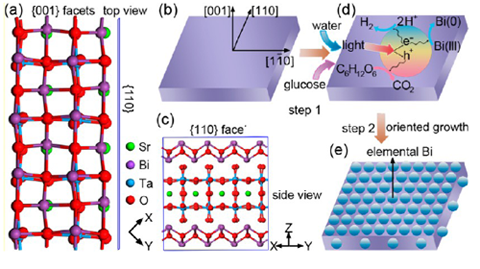Metal nanoparticles (NPs) have attracted enormous attention because of their unique properties and broad applications. There are various methods to prepare metal NPs by solution-phase or vapor-phase.However, preparation of metal NPs by direct reduction of bulk metal oxides at ambient temperature remains a challenge, due to the homogeneity of bulk oxides and the intrinsically slow mass transfer between the solid reactants and products in most solid-state reactions.
Professor WANG Chuanyi’s team at Xinjiang Technical Institute of Physics & Chemistry, Chinese Academy of Sciences (XTIPC) synthesized Bismuth (Bi) nanoparticles from bulk SrBi2Ta2O9 by photochemical approach.
Bi NPs have been considered as catalysts for the growth of dimension-controlled semiconductor quantum wires and rods by the solution–liquid–solid mechanism. There are many methods can be used to synthesize Bi NPs, such as inverse micelles, radiolytic reduction in aqueous solution, the thermolysis of a bismuth-thiolate precursor, and solution-based reduction.
Researchers employed a light-induced approach towards the synthesis of oriented Bi NPs without using organic agents via an in situ topotactic transformation process, in which SrBi2Ta2O9 acts as a physical substrate, chemical source, and crystallization ‘catalyst’. It has been proven that bulk metal oxide can be photoreduced under room condition to produce well-defined nanocrystals.
“Our findings not only enrich the growth mechanisms for hybrid metal-semiconductor nanostructures but also prove that bulk metal oxide can be topotactically reduced to metal NPs with unique structures by a photochemical approach at ambient temperature.” write the authors of the study.
The result has been published on Chem. Mater., 2013, 25 (10), pp 2045–2050.
The work was supported by the National Nature Science Foundation of China, the “One Hundred Talents Project Foundation Program” of CAS, the “Cross-Cooperation Program for Creative Research Teams” of CAS etc..

Formation process of the oriented Bi NPs from SBT (Image by XTIPC)
Contact: WANG Chuanyi
cywang@ms.xjb.ac.cn
Xinjiang Technical Institute of Physics & Chemistry, Chinese Academy of Sciences
